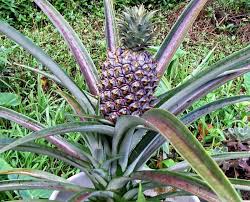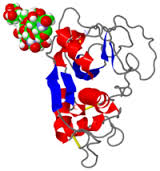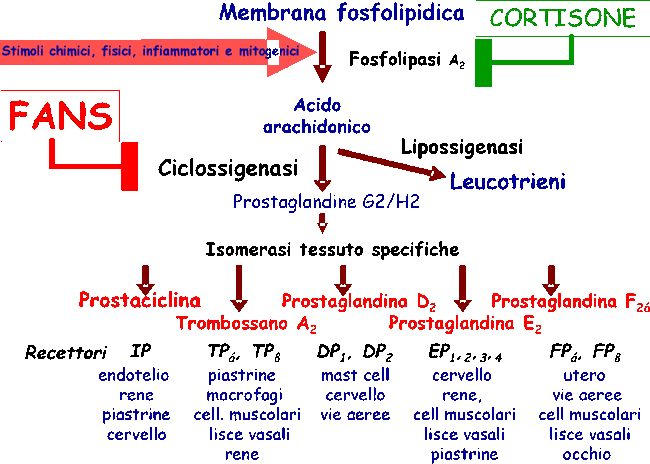Valeria Di Pompa and Chiara Rocca's paper
INTRODUCTION
Bromelain is a crude, aqueous extract from the stems and
immature fruits of pineapples, especially from Ananas Comosus, the main eatable member of
Bromeliaceae, constituting an unusually complex mixture of different proteolytic enzymes.
It was discovered in 1875 and immediately used as phytomedical compound.
 Fig.1 The pineapple tree
Fig.1 The pineapple tree
The first kind of identified Bromelain was the one extracted from pineapple fruit and only
later was identified the Bromelain extracted from pineapple stem.
The Bromelain extracted from the fruit and the one extracted from the stem and their
composition is slightly different, but the effects of the two forms are similar.
The stem of the pineapple contains more Bromelain than the fruit, for this reason the
Bromelain on trade is almost always extracted from the stem (also because the stem is a waste product and its extraction costs less).
DEFINITION
Bromelain is a mixture of different proteinases (thiolic endopeptidases, phosphatases,
glucosidases, peroxidases, cellulases and glycoproteins), organically-bound calcium and several proteinase inhibitors.
Its structure is not so certain, but it mainly comprises glycosylated multiple enzyme species of the papain superfamily with different proteolytic activities, molecular masses between 20 and 31 kD and isoelectric points between > 10 and 4.8.
 Fig.2 A three dimensional structural model of stem Bromelain
Fig.2 A three dimensional structural model of stem Bromelain
Proteolytic enzymes means proteins able to cleave other proteins into amino-acids.
As an enzyme, its concentration is expressed in proteolytic units.
Proteolytic enzymes are usually inactivated by CYSTATIN, substances normally found in saliva; Bromelain stands up well to this inactivation.
The substrate spectrum is similarly broad, extending from synthetic low molecular
mass amides and dipeptides up to high molecular substrates such as fibrin, albumin, casein, angiotensin II and bradykinin. Bromelain preferentially cleaves glycyl, alanyl and leucyl bonds.
In vivo and in vitro, Bromelain’s physiological effects appear to include interactions with
inflammatory, immune, cell signaling, and coagulation molecules and pathways.
Bromelain also appears to have effects on cell surface antigens.
Platelet aggregation inhibitory and antiinflammatory action seem to be related to the protease activity. However, other effects such as inhibition of tumor cell growth and metastasis as
well as debridement of burns are associated with other nonproteinolytic components contained in Bromelain.
Thus, the determination of the proteolytic activity alone may not be sufficient to completely characterize the pharmacological properties of Bromelain.
 Fig.3 A commercial Bromelain preparation
Fig.3 A commercial Bromelain preparation
ABSORPTION AND AVAILABILITY
Bromelain is highly absorbed from the gastrointestinal tract (this is an interesting fact
because the gastrointestinal mucus is commonly considered impermeable to proteins, but not
in this case, in which they overcome it) and without producing main side effects.
Approximately 40% of taken orally Bromelain is absorbed from the gastrointestinal tract in
functional form.
These data suggest the presence of an active transport system.
Its plasma half-life is approximately 6-9 hours.
The highest concentration of Bromelain is found in the blood 1 hour after administration.
Human body can absorb a significant amount of Bromelain, in fact we can consume about
12g/die of Bromelain without main side effects.
Recent research has shown that Bromelain maintains its proteolytic activity also in the
plasma and after administration has been retrieved in the circulation bound to α-2-
macroglobulin and α-1-
antichymotrypsin, two antiproteinase present in the blood.
Bromelain is stable in the stomach even in the presence of gastric juices.
It is also used by injection, but in Italy there are no drugs registered for this use, and in
case of topical one, we usually use 35% of lipid-based Bromelain.
The enzymatic activity of Bromelain are conducted within a broad spectrum of pH, from 5.5
to 8.
Bromelain has a very low toxicity with an DL50 greater than 10 g per kg in rat and rabbit.
A dog-conducted experiment has demonstrated the absence of side effects even after an
administration of 750mg per Kg/day for 6 months.
Clinical studies have shown that Bromelain may be useful in many disorders treatment.
ACTIVITY
ANTI-INFLAMMATORY ACTIVITY
Today, Bromelain is used to treat acute inflammations and sports injuries ,
because it is particularly effective in soft tissue inflammatory states treatment, associated
with trauma, in localized inflammations (especially in the presence of edema) and in post-
operative tissue reactions.

1) Bromelain’s anti-inflammatory action have two different mechanisms: it is in part a result of inhibiting the generation of
Bradykinin at the inflammatory site via
depletion of the plasma Kallikrein system

as
well as limiting the formation of fibrin by reduction of clotting cascade intermediates.

2) Experiments suggest that Bromelain reduces leukocyte migration into inflamed areas
and, secondary to its ability to remove cell surface molecules including the CD128
chemokine receptors, prevents firm adhesion of leukocytes to blood vessels at the site of
inflammation.
3) In vitro evidence suggests Bromelain might be a specific inhibitor of cyclooxygenase-2 (Cox-2)
expression and might induce a significant decrease of substance P concentrations and a significant
decrease in prostaglandin E2 concentrations in vivo.

BROMELAIN EFFECTS ON BLOOD CLOTTING AND FIBRINOLYSIS
Bromelain influences blood clotting by increasing serum fibrinolytic capacity and inhibiting
fibrin synthesis, a protein involved in blood clotting.
Carried out experiments in vivo on rats have shown that fibrinogen reduction levels in the
serum due to the administration of Bromelain was dose-dependent.
They’re considerably prolonged to higher concentration of Bromelain PT (prothrombin time)
and APTT (activated partial thromboplastin time).
Both in vivo and in vitro studies have suggested that Bromelain is an effective fibrinolytic
agent as it stimulates the conversion of plasminogen to plasmin, with a consequent increase
of fibrinolysis since degrades fibrin.
Yuan G , Wahlgvist ML , He G , Yang M , Li D
Natural products and anti-infiammatory activity
2006
BROMELAIN EFFECTS ON CARDIOVASCULAR SYSTEM AND CIRCULATION
1) It prevents or reduces the severity of angina pectoris and TIA (transient ischemic attack).
2) It’s useful in thrombophlebitis treatment and prevention.
3) It can reduce cholesterol plaques and exert a potent fibrinolytic activity.
4) Combined with other nutrients, protects against ischemic injury in skeletal muscle load.
The Bromelain is effective in cardiovascular diseases treatment, because it is an inhibitor of
platelet aggregation in the blood, so reduces thrombosis and embolism risks.
Bromelain intake may also reduce the impact of risk factors that contribute to the
development of cardiovascular diseases.
In a study on ischemia-reperfusion injury, Bromelain increased phosphorylation of
both Akt and foxhead box O3 (FOXO3A) – cell signaling pathways that influence
cardiomyocyte survival - aiding functional recovery of the heart.
It also increased aortic flow and reduced both the infarct size and the degree of apoptosis.
Juhasz B1, Thirunavukkarasu M, Pant R, Zhan L
Bromelain induces cardioprotection against ischemia-reperfusion injury through Akt/FOXO pathway in rat myocardium 2008
A drastic reduction in the incidence of coronary infarct after administration of potassium and
magnesium orotate along with 120-400 mg Bromelain per day has been reported.
In a study involving 73 patients with acute thrombophlebitis, Bromelain plus analgesics
was shown to decrease symptoms of inflammation, including pain, edema, tenderness, skin
temperature and disability.
In hepatic ischemia/reperfusion experiments Bromelain treatment reduced apoptosis and
endothelial cell damage, while lowering AST levels.
A combination of Bromelain and other nutrients protected against ischemia/reperfusion
injury in skeletal muscle.
BROMELAIN EFFECTS ON ALLERGIC-BASED DISEASES
Recent research has found that Bromelain reduces allergic diseases development of the
respiratory tract, acting on lymphocytes populations T CD4+ and CD8+, which is why it is
expected to be useful in asthma and hypersensitivity disorders treatment.
EFFECTS OF BROMELAIN ON IMMUNOGENICITY
Bromelain is recommended as an adjuvant therapeutic approach in chronic inflammation
and autoimmune diseases treatment.
In vitro experiments have shown that Bromelain has the ability to modulate the molecules
adhesion on the surface of T cells, macrophages and NK cells.
In vitro Bromelain also induces the secretion of IL-1β, IL-6 and TNFα by blood
mononuclear cells and also reduces T CD4+ lymphocytes activation and CD25 lymphocytes
activation.
There is evidence that oral treatment with Bromelain produces some anti-inflammatory and
analgesic effects in patients with rheumatoid arthritis.
BROMELAIN ON THE EFFECTS OF DIARRHEA
Studies have suggested that Bromelain combats some intestinal pathogens agents such as
Vibrio Cholerae and Escherichia Coli, whose endotoxins cause diarrhea.
Bromelain appears to carry out this function by interacting with signals that lead to
intestinal secretion, including adenosine 3’:5’-cyclic monophosphate, guanosine 3’:5’-cyclic
monophosphate and calcium-dependent signaling cascades.
Other studies have also shown that Bromelain prevents bacteria's adhesion to the intestinal
wall and binding to specific receptors of the intestinal mucosa.
ANTIBIOTIC POTENTIATION
Combined Bromelain and antibiotic therapy was shown to be more effective than
antibiotics alone in pneumonia, bronchitis, cutaneous Staphylococcus infection,
thrombophlebitis, cellulitis, pyelonephritis, perirectal and rectal abscesses, sinusitis and
urinary tract infections.
Compared to antibiotics and a placebo, combining Bromelain, trypsin and rutin with
antibiotics resulted in earlier improvements in fever reduction and scores on the Glasgow
Coma Scale, suggesting a benefit in pediatric patients with sepsis.
In vitro evidence also suggests potential anti-Candida effects.
Incubation of cells with Bromelain and trypsin stimulate phagocytosis and respiratory burst
killing of Candida albicans.
Pityriasis lichenoides chronica is an infectious skin disease of unknown etiology:
Bromelain reportedly caused complete resolution of this condition.
BROMELAIN EFFECTS OF CANCER CELLS
Recent studies have shown that Bromelain has the ability to modify main pathways that
support cancer cells malignancy.
Presumably, the anti-cancer activity of Bromelain is due to its direct impact on *cancer
cells* and their microenvironment, as well as on the modulation of immune,
inflammatory and hemostatic responses.
Bromelain also appears to promote tumor cells apoptosis.
Most of the experiments both in vivo and in vitro regarding Bromelain antitumor activity
were conducted in rat and human cells, both cancerous and normal.
1) In one experiment conducted in rat cutaneous papillomas, Bromelain treatment has
slowed tumor formation and has fostered cancer cells apoptosis.
2)In one study regarding gastric cancer, Bromelain treatment has demonstrated a
significant reduction in cell growth.
3) In other studies, it was shown that Bromelain reduces glioblastoma cells invasive
capacity and reduces protein synthesis of the same cells.
One of the most important result is that Bromelain promotes cell death by apoptosis of
cancer cells.
Chobotova K, Vernallis AB, Majid FA.
Bromelain's activity and potential as an anti-cancer agent: Current evidence and perspectives 2009
BROMELAIN ROLE IN SURGERY
Administration of Bromelain pre-surgery can reduce the average number of days for
complete disappearance of pain and inflammation postsurgery.
Bromelain has been reported to reduce post-operative swelling and edema.
Two trials indicate Bromelain might be effective in reducing swelling, bruising and pain
in women having episiotomy.
WOUND DEBRIDEMENT
Bromelain applied topically as a cream (35% Bromelain in a lipid base) can be beneficial for
elimination of necrotic tissue and acceleration of healing.
A non-proteolytic component, Escharase,
is responsible for this effect.
Topical application of this preparation has been shown to separate burned or necrotic tissue
(eschar) from living tissue.
Limited evidence also suggests a similar debridement benefit in frostbite.
In these instances this topical preparation is an effective, selective and safe method of
removing necrotic skin from healthy tissue.
Debridement accomplished in this manner is accompanied by minor to moderate pain,
which is generally treated by providing an analgesic.
CONCLUSIONS
Bromelain has a wide range of therapeutic benefits.
It is shown that it is well absorbed in the body after oral administration and has no major
side effects even after prolonged use.
All studies have shown that can be used as a valid health supplement for many diseases
prevention.
Bromelain can also be considered a promising candidate for oral enzyme therapy
development for cancer patients.
Rajendra Pavan, Sapna Jain, Shraddha, and Ajay Kumar 2012
Properties and Therapeutic Application of Bromelain